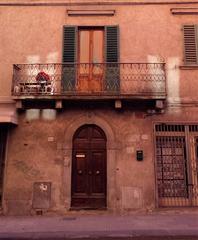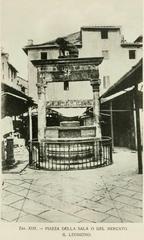Torre di Catilina: Visiting Hours, Tickets, and Historical Sites in Pistoia, Italy
Date: 03/07/2025
Introduction
Located in the heart of Pistoia’s historic center, the Torre di Catilina stands as one of Tuscany’s most compelling medieval landmarks. With its storied past linking Roman legends to the city’s medieval and Renaissance transformations, the tower offers visitors a tangible connection to centuries of history. Although the interior is not currently open to the public, the tower’s impressive exterior, strategic position near Piazza del Duomo, and proximity to other cultural highlights make it an essential stop for travelers exploring Pistoia’s architectural and historical treasures.
This detailed guide covers the history and legends surrounding the Torre di Catilina, its architectural features, practical visitor information—including current visiting hours and ticketing—accessibility, tips for exploring the area, and recommendations for integrating your visit with nearby attractions. Whether you are a history enthusiast or a casual traveler, you’ll find everything you need to optimize your experience and appreciate this remarkable piece of Pistoia’s heritage.
Historical Background and Significance
Origins and Roman Legend
The Torre di Catilina derives its name from Lucius Sergius Catilina (Catiline), a Roman senator infamous for his failed conspiracy against the Roman Republic. According to longstanding local legend, Catilina met his end near Pistoia in 62 BCE after the decisive Battle of Pistoia. Tradition holds that he was buried near what is now Via Tomba di Catilina, close to the tower’s present location. While the historical accuracy of this association is debated, the legend has become an enduring part of Pistoia’s identity, symbolically linking the city to pivotal moments in Roman and Italian history (ViviPistoia).
Medieval and Renaissance Transformations
Constructed in the 13th century, the Torre di Catilina exemplifies the casa-torre style—defensive towers built by powerful families that served as both residences and fortifications. Its robust stone construction and strategic placement provided both security and status. During the Renaissance, under Medici rule, the tower became the seat of the Consiglio di Pratica Segreta, a secret political council. The Medici coat of arms once adorned the façade, later replaced by the de’ Rossi family crest in 1669, reflecting changing ownership and the shifting political landscape.
Modern Era and Restoration
In the 19th century, the Torre di Catilina passed into municipal ownership. Significant restoration efforts in the late 20th century stabilized its ancient masonry and preserved its historical features, ensuring the tower’s survival as a prominent city landmark. Today, the tower’s presence in Piazza del Duomo visually anchors the square and continues to spark the imagination of residents and visitors alike (Visit Tuscany).
Architectural Features
- Height: Approximately 30 meters
- Plan: Rectangular, typical of medieval defensive architecture
- Materials: Local stone and ashlar masonry
- Façade: Largely unadorned except for heraldic emblems of the Medici and de’ Rossi families
- Windows: Narrow, slit-like for defense
- Ground Floor: Originally used for commercial activity (shop or workshop)
- Roof: Modern terrace (not open to the public)
- Ownership: Municipal property since 1815
- Restoration: Major works in the late 20th century ensured its structural integrity (ViviPistoia)
The tower’s austere exterior and strategic location at the corner of Piazza del Duomo and Via Tomba di Catilina highlight its historical role as both a sentinel and a symbol of prestige. Its harmonious integration with surrounding monuments like the Cattedrale di San Zeno and the Palazzo dei Vescovi makes it a key feature of the city’s architectural ensemble (Visit Tuscany).
Visitor Information
Location and Getting There
Address: Via XXVII Aprile / Piazza del Duomo, Pistoia
- On Foot: Torre di Catilina is easily reached by walking from Pistoia’s main train station (approx. 10–15 minutes).
- By Car: The historic center is a restricted traffic zone (ZTL). Use public parking lots on the city’s edge and walk to the tower.
- Public Transport: Numerous bus lines serve stops near Piazza del Duomo.
Visiting Hours and Tickets
- Tower Access: As of July 2025, the interior of the Torre di Catilina is not open to the public. The exterior can be admired at any time.
- Tickets: No entrance fee is required to view the tower from outside.
- Nearby Museums: If you wish to combine your visit with other attractions, museums like Museo Civico di Pistoia and Museo dell’Antico Palazzo dei Vescovi are generally open 10:00 AM–7:00 PM, closed Mondays and Tuesdays (Visit Pistoia Museums Opening Hours).
Accessibility
- Tower: Not accessible to visitors with limited mobility due to medieval design and lack of modern adaptations.
- Piazza del Duomo and Surroundings: The square is largely accessible, though some cobblestone streets may be uneven.
Guided Tours
- Walking Tours: While the tower itself cannot be entered, it is frequently featured in guided walking tours of Pistoia’s historic center.
- Booking: Tours can be arranged through the Pistoia tourist information office in Piazza del Duomo or online (Visit Pistoia).
Tips for Visiting
- Best Photography: Early morning and late afternoon provide optimal lighting for photos.
- Comfortable Footwear: Essential due to cobblestone streets.
- Combine Sites: Plan visits to the Cattedrale di San Zeno, Baptistery of San Giovanni in Corte, and Palazzo dei Vescovi for a comprehensive historical experience.
- Seasonal Events: Look for city events and festivals that occur in Piazza del Duomo for an immersive local experience.
Frequently Asked Questions (FAQ)
Q: What are Torre di Catilina’s visiting hours?
A: The tower is an external monument and can be viewed at any time. The interior is currently closed to the public.
Q: Is there a ticket or entrance fee?
A: No, there is no entrance fee to view the tower from the outside.
Q: Are guided tours available?
A: Yes. Walking tours of Pistoia’s historic center often include the Torre di Catilina as a highlight.
Q: Is the area accessible for people with disabilities?
A: The immediate area is mostly accessible, though the tower and some nearby streets may not be suitable for wheelchairs due to uneven surfaces.
Q: What are the best times to visit?
A: Early mornings and late afternoons are ideal for photography and avoiding crowds.
Nearby Attractions
- Cattedrale di San Zeno: Romanesque cathedral with a striking façade and interior artworks.
- Baptistery of San Giovanni in Corte: 14th-century octagonal baptistery adjacent to the cathedral.
- Palazzo dei Vescovi: Historic bishop’s palace, now hosting art exhibitions.
- Museo Civico di Pistoia: Museum of city history and art.
- Piazza del Duomo: The city’s main square, surrounded by historic buildings.
Visuals and Media
For interactive exploration, see the Virtual Tour of Piazza del Duomo.
Practical Recommendations
- Combine your visit with other major sites in Pistoia’s historic center for a fuller cultural experience.
- Download the Audiala app for audio tours, insider tips, and up-to-date event information.
- Check official websites before traveling for the latest updates on accessibility and special events.
- Respect the site by not climbing or attempting to enter the tower and by keeping the area clean.
Summary and Visitor Recommendations
The Torre di Catilina stands as a lasting symbol of Pistoia’s layered history, from its legendary Roman roots through medieval and Renaissance transformations. While its interior remains closed, the tower’s imposing exterior, rich lore, and central location make it an indispensable highlight of any visit to Pistoia. Surrounded by key monuments and set within the vibrant life of Piazza del Duomo, it offers countless opportunities for exploration, photography, and cultural immersion.
For the most rewarding visit:
- Check museum opening times and consider guided walking tours for deeper context.
- Plan your itinerary to include other historic sites in the piazza.
- Use official sources and local resources to stay informed about seasonal events and accessibility.
For detailed visitor information, consult:
Sources and Further Reading
- ViviPistoia - Torre di Catilina
- Visit Tuscany - Piazza del Duomo in Pistoia
- Visit Pistoia - Museums Opening Hours
- Torre di Catilina in Pistoia: History, Tickets, and Travel Tips, Audiala Travel Guide (provided research data)

